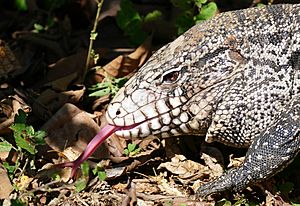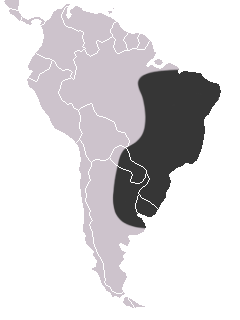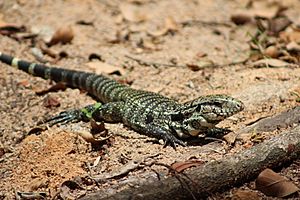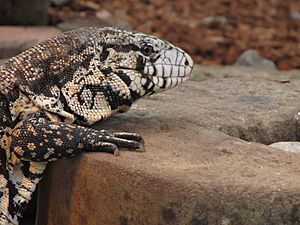Argentine black and white tegu facts for kids
The Argentine black and white tegu (Salvator merianae), also known as the Argentine giant tegu, is a large lizard from the family Teiidae. It is the biggest of all the "tegu lizards." This lizard eats both plants and animals (it's omnivorous) and lives in tropical rain forests, savannas, and semi-deserts in eastern and central South America.
Tegus are sometimes kept as pets because they are very smart. They can even be trained to live indoors, much like a dog! Like other reptiles, tegus go into a sleepy state called brumation in autumn when the weather gets cold. They are very active during the warmer parts of the year. Tegus are special because they are the only known reptiles that can partly control their own body temperature, making them a bit warm-blooded.
Tegus act like monitor lizards in nature, but they are not closely related. This is an example of convergent evolution, where different animals develop similar traits because they live in similar environments.
Quick facts for kids Argentine black and white tegu |
|
|---|---|
 |
|
| Male | |
 |
|
| Female | |
| Conservation status | |
| Scientific classification | |
| Genus: |
Salvator
|
| Species: |
merianae
|
 |
|
| Synonyms | |
Contents
What's in a Name?
The Argentine black and white tegu belongs to the Order Squamata and the Family Teiidae. This family also includes other lizards like racerunners. There are nine different types of tegu lizards. The Argentine black and white tegu is part of the Salvator group.
The second part of its scientific name, merianae, honors Maria Sibylla Merian. She was a German naturalist and artist from the 1600s and 1700s who studied insects, plants, and reptiles.
What Does a Tegu Look Like?
When a Salvator merianae is a baby, it has an emerald green color on its snout and neck, with black marks. This green color turns black after a few months when the tegu sheds its skin. Young tegus have yellow and black stripes on their tails. As they get older, the solid yellow stripes near their body become speckled. Fewer solid stripes mean the animal is older.
A tegu can drop part of its tail if it is attacked. This helps distract the attacker so the tegu can escape. The tail is also used as a weapon to hit an aggressor. Even a gentle swipe can cause a bruise!
Tegus can run very fast and can even run on two legs for short distances. They often do this when defending their territory. They open their mouths and hold their front legs wide to look more scary.
Adult male tegus are much bigger than females. They can grow to be about 3 feet (91 cm) long when they are fully grown. Some males can even reach 4–4.5 feet (120–140 cm) in length. Female tegus are smaller, but they can still grow up to 3 feet (91 cm) long from their nose to the tip of their tail. They have bumpy skin and stripes along their bodies. Adult females can weigh between 2.5–7.0 kilograms (5.5–15.4 lb).
How Can You Tell a Male from a Female Tegu?
When a tegu is about 8 months old, it's easy to tell if it's a male or a female. A male tegu will have a bulge near the base of its tail, while a female's tail base will be flat. In adult tegus, males have much larger jaws (called jowls) because of strong muscles. Females have a smoother jawline.
Where Do Tegus Live and What Do They Eat?
Where Do Tegus Live?
As their name suggests, these tegus are originally from Argentina. They also live in Brazil, Paraguay, and Uruguay.
Argentine black and white tegus are large reptiles that are native to South America. However, you can also find many of them in the southern United States, especially in Florida. They are a problem there because they are an invasive species. This likely happened because some tegus escaped or were released from the pet trade in the early 2000s. Studies show that adult tegus can survive in different climates outside their natural home, which makes people worried about them spreading.
In the wild, tegus live in both forests and open grassy areas. They can also be found in wet places like flooded grasslands, canals, and streams. They don't seem to care much about the type of habitat as long as they can dig burrows.
What Do Tegus Eat?
Tegus are omnivorous, meaning they eat both plants and animals. Young tegus in the wild eat many different small creatures like insects, worms, spiders, and snails. They also eat fruits and seeds. As they grow older, their diet becomes more varied, and they eat more plants.
Adult tegus might look for eggs in other reptiles' or birds' nests. They also eat small birds and other animals like fish, frogs, other lizards, snakes, and small mammals like mice. Even as adults, tegus continue to eat insects and wild fruits. They can also hunt larger prey like armadillos.
When kept as pets, tegus are often fed foods high in protein. This can include raw or cooked meat like ground turkey, chicken, eggs, insects, and small rodents. It's also good to include fruit in their diet. Some pet tegus love fruits like bananas, grapes, mangoes, and papayas. However, it's important to cook most of the egg whites given to them. Raw egg whites contain a protein called avidin, which can prevent the tegu from getting enough biotin, a vitamin they need.
Adult tegus have blunt teeth and strong jaw muscles, which allow them to eat many different kinds of food. In captivity, they eat insects like mealworms and crickets, as well as small animals like mice, rats, fish, and quail. They also eat crayfish. Like all lizards, tegus need a balanced diet. If they eat only insects or ground meat, they need extra vitamins and minerals. Not enough vitamins can cause problems with shedding skin, make them tired, or lose weight. Not enough calcium can lead to a serious bone disease.
Tegus are known for eating eggs, which is a concern in the United States. As an invasive species, they are becoming a threat to sea turtles, alligators, and crocodiles by eating their eggs.
A tegu's diet can change with the seasons. They eat more small animals in the spring, while plants and insects are more common in the summer.
How Long Do Tegus Live?
Argentine black and white tegus are usually born in the spring. When they hatch, they weigh about ten grams. They grow very quickly, reaching up to eight kilograms in four or five years. This means they become about 800 times bigger! During this time, their diet changes from mainly insects to small animals, eggs, dead animals, and fruits.
They can start having babies by their third year, when they weigh around 1.5 kilograms. They stop growing around their fourth year. They grow the fastest in their first two years of life.
Tegu lizards also have a yearly cycle. They are very active during warmer months and go into a sleepy, hibernating state during colder months. Even when they hibernate, their body temperature and how fast their body works (metabolism) do not change much. This is different from other warm-blooded animals and helps explain why tegus can be both warm-blooded and cold-blooded at different times.
How Do Tegus Behave?
Are Tegus Aggressive?
Aggression helps animals survive, especially when food or space is limited. For the Argentine tegu, their large size can sometimes make it harder for them to be aggressive by biting. However, tegus with stronger bites tend to be more aggressive towards threats, no matter if they are male or female. Tegus with stronger bites also try to escape less and are slower. This shows a trade-off between fighting and running away. They might fight more because their heavy heads (which help with biting) make it hard to move quickly.
When tegus are in their own territory, they are usually less aggressive. They are also less likely to try to escape, no matter their size or bite strength.
How Do Tegus Reproduce?
Lizards and snakes often use smells to find mates. Argentine black and white tegus do this too. In the spring, they will pause and turn as they follow scent trails. Female tegus follow these scent trails more strongly than males and are more sensitive to mating smells. They also make more clear decisions, which is common for female animals when it comes to reproduction. Scientists are studying this behavior to help control the spread of tegus as an invasive species. Removing female tegus from an area could be a good way to reduce their numbers.
Tegus dig burrows in both their native and invasive homes, especially in winter. They mate in the spring after hibernating, when their mating hormones are highest. During spring, male tegus mark their territory with scents from their glands.
Tegus can lay eggs up to twice a year. They usually lay between 18 and 25 eggs in a clutch, but sometimes more, depending on the female's size and health.
During the time they are caring for eggs, female Argentine black and white tegus build nests from dry grass, small branches, and leaves. They do this to keep the eggs at the right temperature and humidity. The eggs usually hatch after about 64 days, but it can range from 40 to 75 days depending on the temperature and other factors.
How Do Tegus Survive So Well?
Why Are Tegus Good at Being Invasive?
Tegus have traits that help them succeed as an invasive species. They grow up quickly, have babies every year, lay many eggs, and live a relatively long time compared to other animals. Among their family, Teiidae, tegus grow to be the largest. Tegus also eat many different things, from fruits and insects to small animals, eggs, and dead animals. Their wide diet helps them survive well outside their native homes.
Tegus are active during certain seasons. They avoid very cold or dry weather by hibernating underground. They can also use their own bodies to raise their temperature when it's cold outside.
Are Tegus Warm-Blooded?
In their native homes, tegus spend most of the colder months hibernating in their burrows without eating. But in spring, they come out to mate. While hibernating, their bodies make heat, keeping their temperature a few degrees warmer than the burrow. This means they are partly warm-blooded. This ability to control their own temperature continues into the reproductive season. However, Argentine tegus only do this for part of the year. For the rest of the time, they act like cold-blooded animals, warming up by sunbathing. Both male and female tegus show this behavior.
The Argentine tegu's body temperature and how fast its body works change a lot with the seasons. They are very active during warmer months, especially during mating season in spring. They slow down their bodies a lot during winter.
Salvator merianae has recently been found to be one of the few lizards that is partly warm-blooded. Their body temperature can be up to 10 °C (18 °F) higher than the air temperature at night. However, unlike truly warm-blooded animals like mammals and birds, these lizards only control their temperature during their reproductive season (September to December). This is called seasonal reproductive endothermy. This discovery helps scientists understand how warm-bloodedness might have first developed in birds and mammals, possibly for reproduction.
Tegus and Humans
Tegus as Pets
When black and white tegus are kept as pets, they can be fed proteins, fruits, and vegetables. Good protein sources include live insects like mealworms and crickets, scrambled or hard-boiled eggs, snails, chicks, cooked organ meats, shrimp, and mice or rats (either live or frozen and thawed).
For fruits and vegetables, they can eat berries like strawberries and blueberries. They can also have bananas, apples, kiwis, pears, pumpkins, melons, peas, squash, apricots, mangos, figs, papayas, cantaloupe, and grapes.
Blue Tegus
The blue tegu is a type of tegu known for its light blue color. This color is brightest in adult males. Even young blue tegus can be told apart from other black and white tegus by a "singe mark" on their nose. Blue tegus are often considered good pets and can be tamed easily. In the wild, they will usually try to run away or act aggressively if bothered.
Scientists are still debating how to classify the blue tegu. Some think it's a natural change (mutation) of the Argentine black and white tegu. Others believe it's different enough to be its own species or a subspecies. The first blue tegu brought out of South America came from Colombia.
The color of a "blue" tegu can range from simple black and white to albino, powder blue, or even 'platinum' (a very white color). The distinct blue color usually doesn't show up until the animal is about 18 months old or grows to 2 feet (61 cm) or more. Like the Argentine black and white tegu, blue tegus grow very fast, reaching almost 75% of their full length in just one year. Adult females can be about 2.5 feet (76 cm) long, while adult males can be longer than 4 feet (122 cm). Tegus are very strong, heavy animals, weighing 7 to 12 pounds (3.2 to 5.4 kg) or more when fully grown. Their size depends on their genes, how they are cared for, and what they eat.
Caring for Pet Tegus
Because of their size, a single adult tegu needs a cage that is at least 6 feet (183 cm) long, 3 feet (91 cm) wide, and 2 feet (61 cm) high. The bigger the floor space, the better. A pair of adults would need twice that much space.
You should use about six inches of bedding (substrate) in the cage so the tegu can burrow. The bedding should also hold humidity well. Many owners use cypress mulch mixed with coconut fiber because it keeps humidity well and is easy to buy. Only use natural bedding without pesticides or additives, as these can make your tegu very sick.
A good UVA and UVB light bulb is very important for a tegu's health. They need UVB light to make Vitamin D in their bodies, which helps them use calcium. If they don't get enough UVB every day, they can have severe pain or bone problems from diseases like metabolic bone disease.
Along with UVB, a tegu also needs a temperature gradient in its cage. This means one side of the cage should be cooler, and the other side should be much warmer with a basking spot. This allows the tegu to move to the temperature that feels best for it. The cooler side of the cage should be around 75 °F (24 °C), and the warmer side should be about 90 °F (32 °C). The surface of their basking spot needs to be even warmer. For young tegus, it should be around 100 °F (38 °C). As they get older, it can go up to 110–120 °F (43–49 °C). For healthy shedding of their skin, the humidity in the cage should be between 60-80%.
Like most lizards, tegus need fresh water every day. They should have a water dish big enough for them to soak in if they want. Some tegu species also enjoy swimming. Since they can grow to be about 1 metre (1 yd) long or more, a medium to large cat litter box can work as a water dish. Never let the water level be above the tegu's shoulders, as many tegus can drown if left alone in deep water.
Are Tegus Legal as Pets?
In some places, there are rules about keeping tegus. For example, on May 28, 2021, the South Carolina Department of Natural Resources made it illegal to bring in or breed black and white tegus in South Carolina. Tegus already there must be registered.
Tegus as Food
In their native homes, S. merianae are sometimes eaten by humans, like many other animals used for food. They could be a good source of meat for people.
Tegus in the Leather Trade
The Argentine black and white tegu has been hunted for a long time for its skin, which is used to make leather. They are one of the most used reptile species in the world for this purpose. However, this trade is legal in most South American countries. The species is not considered endangered, and there haven't been reports of too many being taken from the wild.
Why Are Tegus an Invasive Species?
In Florida, Argentine black and white tegus have escaped from the pet trade and are now an invasive species in Florida, Georgia, and South Carolina. The first time a S. merianae was seen in Berkeley County, South Carolina, was on September 10, 2020. Eight sightings in South Carolina had been reported by that date.
The Argentine black and white tegu is a particular threat to native birds and reptiles that build nests or burrows on the ground. They show a special type of behavior called intraguild predation. This means Argentine tegus will hunt and kill other native reptiles, but they won't always eat them. This makes their harmful effect on wildlife even worse. Efforts like setting traps or local hunting have not been very successful in reducing their negative impact in areas where they are not native.
Because tegus threaten native and endangered species, efforts to control their populations have been a priority for the past ten years. Nearly 3,300 tegus have been removed from Miami-Dade County alone. Sadly, these efforts have had little effect. Historically, tegus survived harsh hunting for the leather trade in their native homes, showing that they are a very tough species.
As of April 29, 2021, people living in Florida are now allowed to kill these invasive Argentine black and white tegus if they see them on private property (with the owner's permission) or on public lands in Florida. Laws that used to protect these non-native reptiles have been removed to stop the tegu population from growing in Florida. As another option, the Florida Fish and Wildlife Conservation Commission (FWC) staff offer to capture and remove tegus from the environment.
How Are Tegus Classified?
In 1839, this tegu species was first named Salvator merianae. However, for 154 years, starting in 1845, it was mixed up with Tupinambis teguixin and thought to be the same species. In 1995, it was again given its own species status as Tupinambis merianae because studies showed it was different from the gold tegu (Tupinambis teguixin). In 2012, the Argentine black and white tegu was moved back to the original group Salvator and named Salvator merianae.
S. merianae is called the "Argentine black and white tegu" to tell it apart from the "Colombian black and white tegu," which is another name for the gold tegu. Some dishonest or unknowledgeable pet sellers sometimes sell gold tegus as if they were Argentine black and white tegus.
You can tell S. merianae and T. teguixin apart by looking at their skin texture and how many scales they have:
- S. merianae has two scales between its eye and nostril (called loreal scales).
- T. teguixin has only one loreal scale between its eye and nostril.
In some areas of central Argentina, Argentine black and white tegus are known to naturally breed with the red tegu (Salvator rufescens), creating a stable area where their mixed offspring live.
See Also
 In Spanish: Lagarto overo para niños
In Spanish: Lagarto overo para niños
- Gold tegu
- Tegu
- Teius
- Teius teyou





